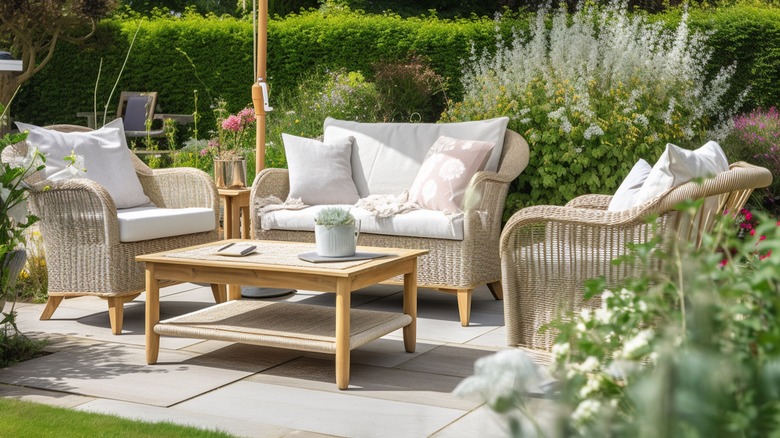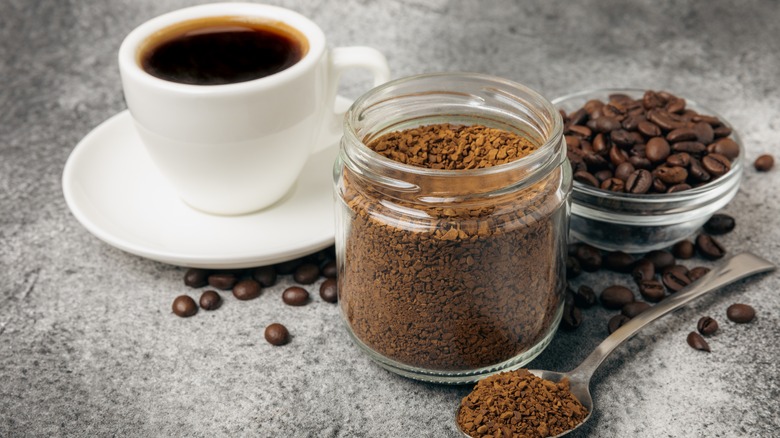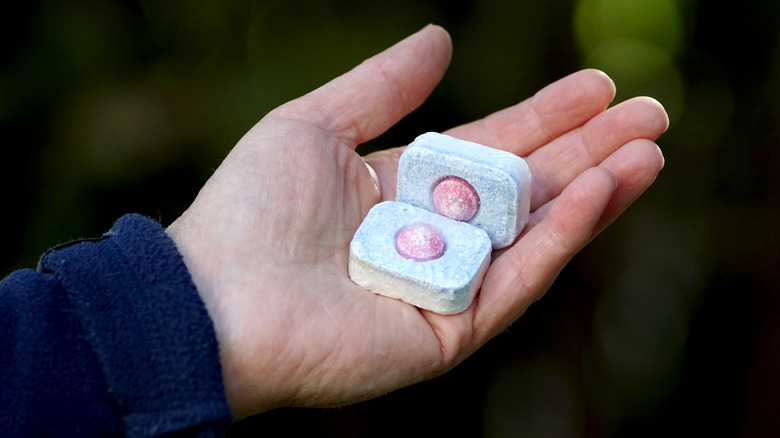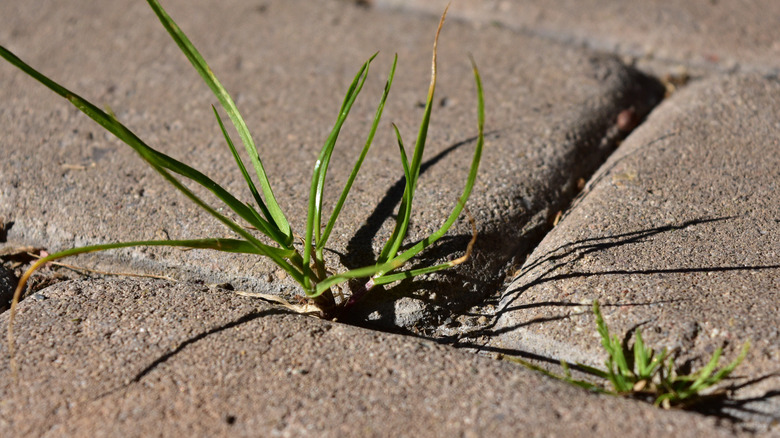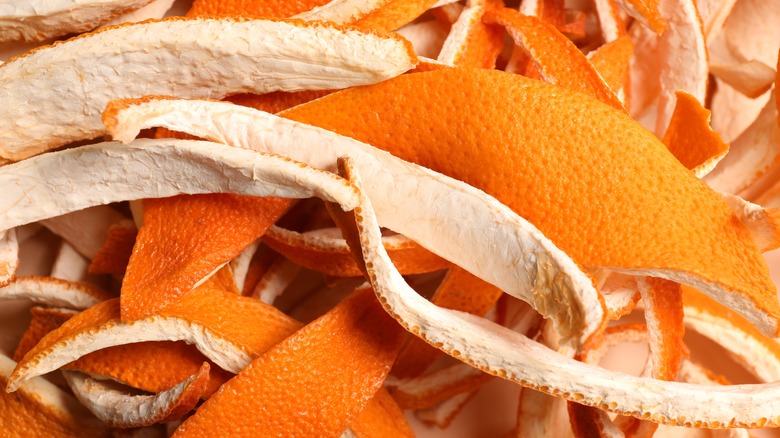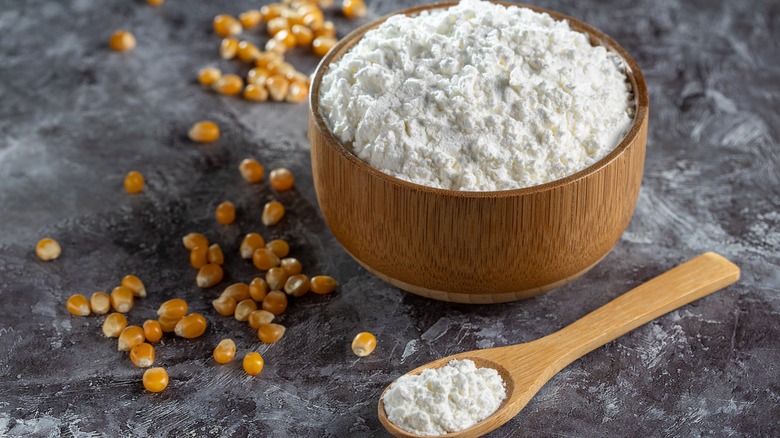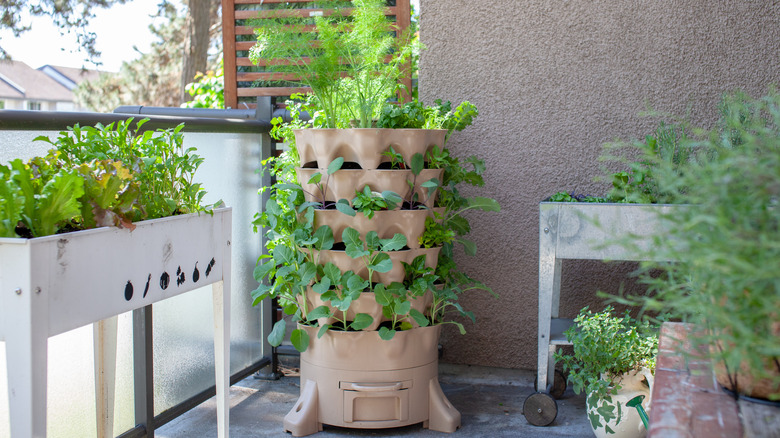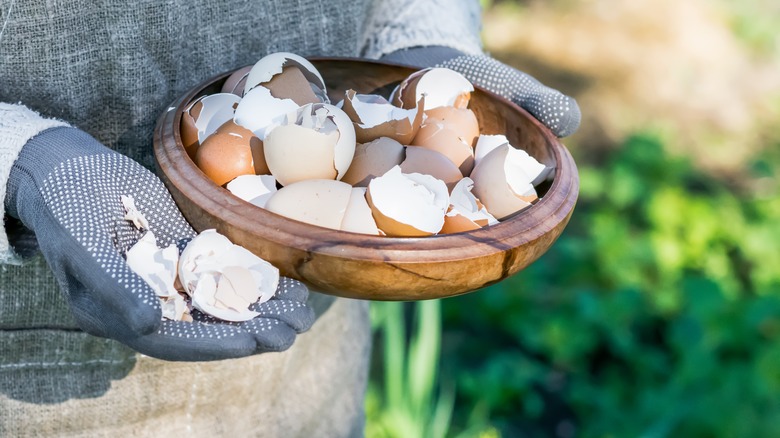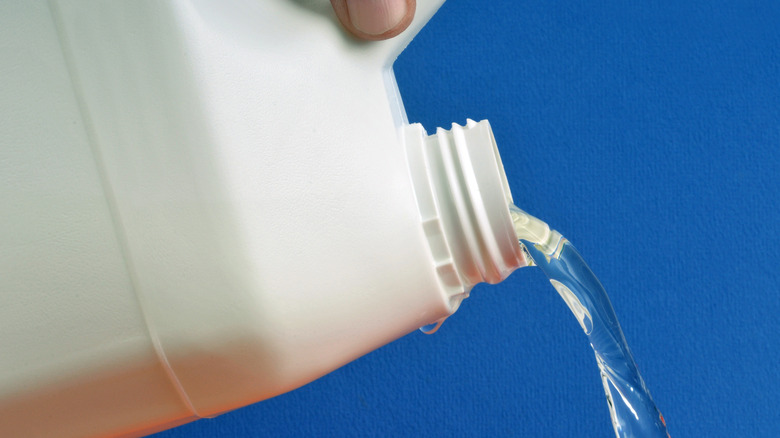Common Kitchen Ingredients You Should Use Around Your Patio
We may receive a commission on purchases made from links.
Once spring rolls around and temperatures begin to turn pleasant again, it's time to get your patio ready for the season. Creating a space that is clean and free of pests will produce a relaxing atmosphere, while also providing an inviting entertainment area for hosting friends and family. Memories can then be made while sipping glasses of iced tea on a hot afternoon or when serving a barbecue feast on a Saturday night. To get your patio in tip-top shape, you need look no further than your kitchen. It is there that you will find powerful cleaning agents, pest repellents, and air fresheners.
Repurposing kitchen ingredients not only contributes positively to the environment, but it also keeps your household budget intact. You can skip running to the store for a host of cleaners and chemical repellents and instead harness the power of ingredients such as vinegar, cornstarch, and basil. Vinegar has the ability to kill weeds that may be emerging through your patio pavers, while cornstarch is best for absorbing stains. Grab basil to repel flies. When you've finished working on your patio using these essential kitchen pantry items, you'll find you have a pristine, pest-free oasis that is sure to be a delight to the entire family.
Use coffee grounds to repel mosquitoes
There's nothing worse than heading out to the patio to enjoy a relaxing cup of tea with a good book only to be swarmed by mosquitoes. One way to combat these pests and reclaim your space is to use a jar of coffee grounds. A 2015 study published by the BioMed Central showed coffee was effective at not only repelling Aedes albopictus mosquitoes, but it also stopped the development of the mosquitoes' embryos. Since you can purchase a container of fresh coffee grinds at Walmart for under $6, you'll find it's quite an affordable way to keep the blood-sucking pests at bay.
To repel mosquitoes from your patio, simply pour coffee grounds into a bowl. You'll want to use several bowls and then strategically place them around your patio. The larger the space, the more bowls you'll want to use. Set a bowl near any entrance or exit point and then place another bowl by your designated seating area. As the fragrance of the coffee begins to diminish, swap out the old grounds with new. You'll only need to do this during the months where temperatures reach 50 degrees Fahrenheit and above. Mosquitoes will go dormant during the colder months.
Use dishwasher tabs to remove stains from patio furniture
Patio furniture can become riddled with stains and dirt over time, as families make frequent use of the setup. The furniture pieces are also susceptible to being plagued with pollen during the spring months. You may be surprised to learn that dishwasher tabs are the key to a cleaner outdoor space. They are tiny, yet powerful, when it comes to providing a thorough clean. They can be used for much more than just dishes. Professionals use them to clean both patio furniture and the stains on the patio's concrete flooring.
Before you can begin cleaning your patio furniture or flooring with the dishwasher tabs, you'll need to dissolve them in a bucket of hot water. One tablet per 5-gallon bucket is all you need, although, if you need to do a spot treatment for a tough stain, you can wet the dishwasher tab and then give the stain a quick rub. Dip a sponge into the cleaning solution and wipe down the furniture as you normally would. For concrete stains, you'll need to use a brush to apply the cleaning solution. Once applied, wait 10 minutes before rinsing the concrete with water. Warning: Never use dishwasher tabs to clean wicker or wooden furniture.
Use vinegar to kill weeds in between patio pavers
Pavers can be quite an attractive option when it comes to patio flooring; however, they have one big pitfall: Weeds often grow up within the tiny spaces between the pavers. If you opted for pavers for your patio, there's actually a common kitchen ingredient that you can use to get rid of the unsightly vegetation. According to Montana State University, vinegar in a higher concentration can be used to kill weeds in between patio pavers. The vinegar works on contact by rupturing the weed's cells, which causes it to dry out.
Purchase vinegar that has an acetic acid concentration of 20%. You can get a large bottle on Amazon for just under $24 that should last through the growing season. Put on a pair of gloves and goggles and then pour the vinegar into a spray bottle. Coat the weeds between your patio pavers with the vinegar, as it won't kill any parts it doesn't touch. Keep in mind that the vinegar will kill any vegetation that it comes into contact with, so make sure you don't use it around any border plants. Within 24 hours, you'll begin to see the weeds die off. Repeat as soon as you notice any new growth to maintain control.
Use orange peels to repel cockroaches
Cockroaches not only carry bacteria that are harmful to humans, but they are also known to trigger attacks in individuals with asthma. The tiny creatures multiply quite rapidly, producing as many as 300 new bugs in just 12 months. Rather than trying to tackle a cockroach infestation, it's best to take steps to deter the pests from ever stepping foot on your patio in the first place. As long as you have some orange peels handy, you can do just that! Experts report that orange peels act as a natural cockroach deterrent. A 2001 study published by Bioresource Technology revealed that the peel from Citrus sinensis (sweet orange) had insecticidal activity against cockroaches.
To repel cockroaches from your patio using orange peels, you'll need to have fresh peels readily available. The peels can be sliced up into smaller pieces and placed in decorative bowls throughout your patio, or they can be ground up in a blender and sprinkled around the perimeter of your patio. The important thing to note is that the orange peels only work when fresh, as their scent diminishes over time. Replacing the orange peels regularly is necessary to continue enjoying protection from the repulsive insects.
Clean patio screens and tracks with Dawn Powerwash
Another kitchen ingredient to keep on hand for sprucing up your patio is Dawn Powerwash. This dish soap isn't just for scrubbing heavily soiled pots and pans. It also works effectively to get your patio tracks and screens free of caked on dirt, grime, and bugs. Dawn's new formula was released back in 2019 and it has quickly gained popularity simply because it works. In addition to adding rubbing alcohol as an ingredient, Dawn also designed the bottle to produce suds in the spray chamber. There's no need to water the product down, which means you'll get the full cleaning power every time.
To use Dawn Powerwash to clean your patio tracks, spray the product directly on the tracks. Grab a clean paintbrush and start working it back and forth over the tracks. Not only will this method dislodge dirt, but it will also safely scrub the cleaner across the tracks. Afterward, wipe the area with a moistened paper towel before drying it with a new paper towel sheet. When it comes to your patio screens, you'll need to mix the Dawn Powerwash with hot water in a bucket. Dislodge the dirt with a soft-bristled broom or brush and then dip a mop into the solution and go over the screen from top to bottom. Grab a leaf blower and blow all of the dirt and cleaning solution away. No need to rinse, and you now have an immaculate screen!
Soak up oil stains with cornstarch
Concrete flooring offers many benefits when it comes to patios, as it is durable, affordable, and easy to maintain. It is prone to stains, however. In the event that your concrete experiences an oil spill, you'll need to know how to clean the concrete patio in a few simple steps. One method is to use a common pantry staple: cornstarch. Cornstarch works to absorb the oil, doing all of the hard work for you.
Once you've removed all of the items on your patio flooring, you'll be ready to tackle any stains. Start by completely covering any oil stains with cornstarch. Wait 30 minutes for the cornstarch to absorb the oil before sweeping it up and tossing it in a nearby trash can. Any remaining stain left on the concrete can now be removed using hot water mixed with a few drops of a liquid dish soap that is listed as having degreasing properties. Scrub the cleaning solution over the stain using a soft-bristled brush and then rinse the area clean. Note: If you don't have any cornstarch on hand, kitty litter and sawdust will also work.
Grow herbs in a planter to repel flies
While many flies don't bite, they are still a nuisance. They land on your food and buzz about, disrupting your peaceful afternoon. If your patio isn't screened in, chances are you'll be plagued with flies throughout the summer season. Instead of having to grab a fly swatter multiple times per day, create an atmosphere that repels the flies. This is easily done by setting out a planter that contains all the herbs flies hate. Since you also get to use the fresh herbs to liven up your favorite meals, in addition to repelling the pesky insects, it's a win-win!
Choose which of the fly-repelling herbs you'd like to plant. Basil produces a scent that is repugnant to flies (and it tastes great in pasta dishes). It does best in full sun and can be grown outdoors in U.S. Department of Agriculture plant hardiness zones 10 and 11. Lemongrass contains citronella oil, which is widely known to repel flies and mosquitoes. This herb grows best in USDA zones 8 through 11 and also enjoys full sun. Additionally, you could grow mint, which not only deters flies, but also provides a garnish for foods and drinks. Mint is hardy in USDA zones 3 through 8 and a fan of full sun. The only downside to mint is that it grows rapidly. You'll need to harvest or cut back the mint often to keep it in check.
Use lemons and rosemary to create pest repellent candles
You don't have to grow any plants to keep insects away from your patio — you can actually utilize two common kitchen ingredients and create a pest-repellent candle instead. A few lemon slices and a bit of rosemary act as the primary ingredients in the candle, and as their scent is released into the air when the candle burns, mosquitoes in particular run the opposite direction. Of course, the scent is quite pleasant to humans, so you're sure to enjoy the refreshing aroma the candle provides to your patio space. As an added benefit, the candle gives a bit of romantic lighting in the evenings.
To create the candle, you'll need a glass jar. A small mason jar works well for this. Place several lemon slices down inside the glass jar followed by a sprig of rosemary. Fill the jar with water, leaving enough room at the top for a floating candle. Light the candle and enjoy a pest-free patio. To increase the homemade candle's pest deterrent capabilities, add a few drops of lemon and eucalyptus essential oils to the water.
Create a natural air freshener using lemons
To thoroughly enjoy your patio, you'll want to create an atmosphere that appeals to all the senses. Using lemons to make a natural air freshener is a great way to engage your sense of smell. Lemons produce a pleasant citrus aroma that is often synonymous with a deep clean. Before you create and disperse your lemon air freshener, you'll want to follow the tips above to get the patio clean.
Grab a spray bottle and add 8 ounces of cold water. Squeeze in the juice of one lemon and then give the bottle a shake to combine the ingredients. You could also use lemon juice from a bottle, or lemon essential oil if you have it. Spray the homemade air freshener around the patio to liven up the space. Reapply anytime you want a burst of citrus to fill the air. Not interested in using a spray? You can also soak cotton balls in the mixture and then place them in bowls on the tables in your patio.
Use baking soda to scrub resin or plastic patio furniture
Since it's best not to use dishwasher tabs on patio furniture made of plastic, you'll need to resort to a different cleaning method. The household staple baking soda is the perfect solution for furniture pieces made of either plastic or resin. Baking soda cleans, deodorizes, and removes stains gently, so you never have to worry about the product leaving behind any scratch marks.
Fill a bucket with 3 gallons of hot water and then add 1 cup of baking soda. Stir until the two ingredients are combined and then grab a sponge or a soft-bristled brush. Give the patio furniture a good clean to remove dirt, pollen, and any bug residue from the pieces remaining in storage over the winter. Rinse the furniture down using the water from your garden hose. If it's a nice sunny day, leave the pieces out in the sun to dry before returning them to your patio. Otherwise, you'll need to use a lint-free towel to dry the furniture off.
Use eggshells to fertilize patio plants
When working in the kitchen, there's one ingredient you'll want to save instead of tossing. Eggshells can be repurposed to give patio plants more calcium. Roses, geraniums, lilies, and snapdragons all do well when eggshells are added to their soil. If you grow any vegetable container gardening on your patio, you'll also find eggshells pair well with tomatoes, cucumbers, peppers, and eggplants. It's important to note that the eggshells must be crushed into a powder before they are able to benefit your patio plants.
To make your eggshell fertilizer, rinse off the eggshells and then set them in your microwave for two minutes. Use a coffee grinder to turn the eggshells into a powder. Apply the powder of two to three eggshells to each of your patio plants. It's also possible to boil between 10 and 20 eggshells to create an eggshell tea to feed your plants. Simply strain out the shells before giving your flowers a drink. Repeat every month or two during the growing season to continue to provide your plants with extra nutrition. If you have any leftover shells, you can always toss them in your compost pile.
Use bleach to remove mold and mildew from patio furniture fabric
The fabric on your patio furniture can become infested with mold and mildew while overwintering outside or in a garage. This tends to happen when the pieces are stored in a damp environment, or are allowed to get wet when it rains. Before you toss the fabric, head to the cabinet under your kitchen sink and grab a bottle of bleach.
Check that the fabric is safe for bleach. Indoor fabric typically is not; however, most outdoor fabrics are safe. Fill a bucket with 3 gallons of water. Add 3 cups of bleach and ¾ cup of your preferred liquid laundry detergent. Stir to combine. Test an area of the fabric, and if the color doesn't fade, you can proceed. Apply the cleaner to the fabric and then let it sit for 15 minutes. If there are any stains, you'll need to scrub them using a soft-bristled brush. Rinse the fabric and then set the furniture out in the sun to dry.
